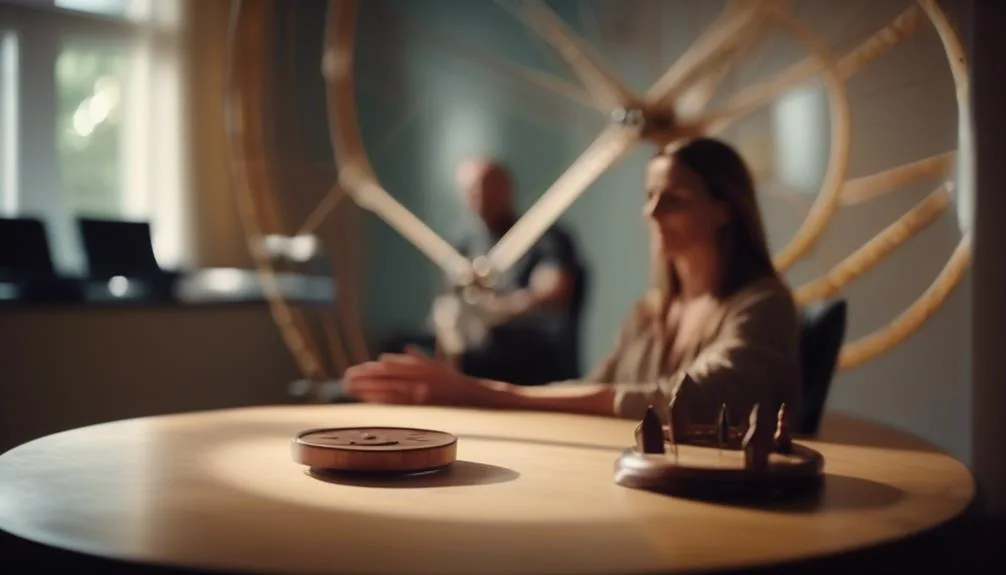Are you tired of feeling like a passenger in the rollercoaster of your emotions? Ready to take the wheel and steer your emotional journey in the right direction? Look no further.
In this discussion, we will unravel the secrets of 'Unleash Your Emotions: Master the Wheel' – a transformative approach to understanding and managing your emotions. Discover how Plutchik's Wheel of Emotions can revolutionize the way you navigate the complexities of your feelings.
Brace yourself for a journey of self-discovery and emotional empowerment, as we unveil the tools and techniques to help you take control of your emotions. Get ready to embark on a fascinating exploration of emotional intelligence and unlock your true potential.
Key Takeaways
- Plutchik's Wheel of Emotions is a model proposed by psychologist Dr. Robert Plutchik that consists of eight primary emotions and their polar opposites.
- Emotions play a crucial role in survival and can be influenced by evolutionary history.
- The wheel can be used as a tool to identify and understand different emotions, enhance emotional intelligence, and facilitate emotional regulation.
- The Geneva Emotion Wheel is another model that categorizes emotions based on dimensions such as valence and arousal, offering a different perspective on understanding and categorizing emotions.
Understanding Plutchik's Wheel
If you're looking to gain a deeper understanding of your emotions and how they influence your life, Plutchik's Wheel of Emotions is a valuable tool to explore. This wheel is a scientific approach to exploring emotions and their complex nature. It provides a framework for categorizing emotions and understanding their relationships.
However, like any model, there are some critiques of Plutchik's Wheel. Some argue that it oversimplifies the complexity of emotions by reducing them to just eight primary emotions. Others suggest that it doesn't account for cultural and individual differences in emotional experiences.
Despite these critiques, the wheel can still offer valuable insights into the world of emotions. It serves as a starting point for exploring and understanding the vast range of emotions that shape our lives.
Applying the Wheel in Everyday Life

Now that you have a deeper understanding of Plutchik's Wheel of Emotions and its significance in exploring the complexity of emotions, let's explore how you can apply this valuable tool in your everyday life. The wheel is not just a theoretical concept; it can serve as a practical guide in your relationships and personal growth.
Applying the Wheel to Relationships
When it comes to relationships, the Wheel of Emotions can help you navigate the ups and downs. By recognizing and understanding your own and others' primary emotions, you can foster empathy and better communication. For example, if your partner expresses anger, you can use the wheel to identify the underlying emotion of fear or sadness, allowing you to respond with compassion and support.
Using the Wheel for Self-Reflection
Self-reflection is a powerful tool for personal growth, and the Wheel of Emotions can enhance this process. Take a moment to reflect on your emotions throughout the day and identify the primary emotions you experience. This self-awareness will enable you to better understand your emotional patterns and triggers, helping you make more informed choices and manage your emotions effectively.
| Applying the Wheel to Relationships | Using the Wheel for Self-Reflection |
|---|---|
| Foster empathy and better communication | Enhance self-awareness and personal growth |
| Recognize underlying emotions in others | Identify emotional patterns and triggers |
| Respond with compassion and support | Make informed choices and manage emotions effectively |
Comparing Different Emotion Wheels

When comparing different emotion wheels, it's fascinating to observe the unique perspectives and categorizations that each model offers.
One popular model is Plutchik's Wheel of Emotions, which focuses on eight primary emotions and their polar opposites. The advantage of Plutchik's wheel is that it provides a solid foundation for understanding and categorizing emotions. By identifying these primary emotions, individuals can better navigate and manage their feelings.
However, one limitation of Plutchik's wheel is that it may oversimplify the complexity of emotions by reducing them to a limited number of categories. It's important to remember that emotions are multi-dimensional and can vary greatly from person to person.
Therefore, while Plutchik's wheel offers valuable insights, it's essential to consider other emotion wheel models that provide different perspectives and categorizations.
Utilizing the Wheel in Counseling Sessions

As a counselor, you can leverage the valuable insights provided by Plutchik's Wheel of Emotions to foster emotional exploration and expression in your counseling sessions. Utilizing the emotion wheel can bring numerous benefits to your clients.
By using this tool, you can help your clients identify and understand their emotions more effectively. The wheel can serve as a guide to explore the complex nature of emotions and their interconnectedness. It can assist in identifying patterns and triggers for specific emotions, allowing for a deeper understanding of the client's emotional experiences.
The wheel also facilitates communication between you and your client, creating a safe space for them to express their emotions. As a counselor, you can use various techniques to guide your clients in exploring their emotions, such as asking open-ended questions, encouraging self-reflection, and validating their emotions.
Achieving Emotional Control Through Vertical Development

To gain better control over your emotions and enhance your emotional well-being, it is crucial to embark on a journey of vertical development. Vertical development refers to the growth and transformation of your emotional intelligence. It involves developing a deeper understanding of emotions and their impact on your behavior. Through self-reflection techniques and self-awareness, you can regulate your emotions effectively.
One way to visualize this journey is through a 2 column and 3 row table:
| Emotion | Description |
|---|---|
| Joy | A feeling of happiness and contentment. |
| Sadness | A state of unhappiness or sorrow. |
| Anger | A strong feeling of displeasure or rage. |
| Disgust | A feeling of intense dislike or aversion. |
| Fear | An emotional response to a perceived threat. |
| Surprise | The feeling of being taken aback or amazed. |
Unleashing Your Emotions: Practical Tips and Techniques

Ready to unleash your emotions and discover practical tips and techniques to navigate through them with ease? Here are four ways to effectively manage your emotions during stressful situations and express them in a healthy manner:
- Take deep breaths and practice mindfulness: When faced with intense emotions, pause and take a few deep breaths. This can help calm your nervous system and bring you back to the present moment. Practice mindfulness by observing your emotions without judgment.
- Find healthy outlets for expression: Engage in activities that allow you to express your emotions in a constructive way. This could include journaling, talking to a trusted friend, or engaging in physical exercise. Finding healthy outlets can prevent emotions from building up and becoming overwhelming.
- Identify and challenge negative thoughts: During stressful situations, our thoughts can often become negative and irrational. Take the time to identify these thoughts and challenge them with more rational and positive alternatives. This can help you gain a more balanced perspective and manage your emotions more effectively.
- Seek support when needed: Don't hesitate to reach out for support when you need it. Whether it's talking to a friend, seeking guidance from a therapist, or joining a support group, having a support system in place can provide you with the necessary tools and encouragement to express your emotions effectively.
Frequently Asked Questions
How Does Plutchik's Wheel of Emotions Relate to Evolutionary History and Survival?
Plutchik's Wheel of Emotions reveals how emotions are shaped by evolutionary history and survival instincts. Understanding this connection helps you navigate and regulate your feelings, enhancing your emotional intelligence and well-being.
What Is the Main Difference Between Plutchik's Wheel of Emotions and the Geneva Emotion Wheel?
The main difference between Plutchik's Wheel of Emotions and the Geneva Emotion Wheel lies in their categorization and focus. Plutchik's wheel emphasizes primary emotions and their polar opposites, while the Geneva Emotion Wheel categorizes emotions based on valence and arousal.
How Can an Emotion Wheel Be Used in Counseling Sessions to Facilitate Communication and Emotional Exploration?
To facilitate communication and emotional exploration in counseling sessions, use the emotion wheel. It helps you understand and express emotions, identify triggers, and develop awareness and regulation skills. Improve relationships and explore cultural differences through the wheel.
What Is Vertical Development and How Does It Contribute to Better Emotional Control?
Vertical development is the key to better emotional control. It involves growing emotionally and gaining a deeper understanding of your feelings. Through self-awareness and regulation, you can unleash your emotional growth and master the wheel of emotions.
What Are Some Practical Tips and Techniques for Unleashing and Mastering Your Emotions Using the Emotion Wheel?
To unleash and master your emotions using the emotion wheel, start by familiarizing yourself with its primary emotions. Use it as a tool to identify and manage your feelings, enhancing communication and emotional exploration in counseling sessions.
Conclusion
Congratulations! You're now equipped with the powerful tool of Plutchik's Wheel of Emotions to navigate through the complexity of your feelings.
Did you know that studies have shown that individuals with high emotional intelligence are 58% more likely to succeed in their personal and professional lives?
By mastering the wheel, you're on your way to unlocking your emotional potential and achieving greater success.
So, don't wait any longer – unleash your emotions and start mastering the wheel today!

